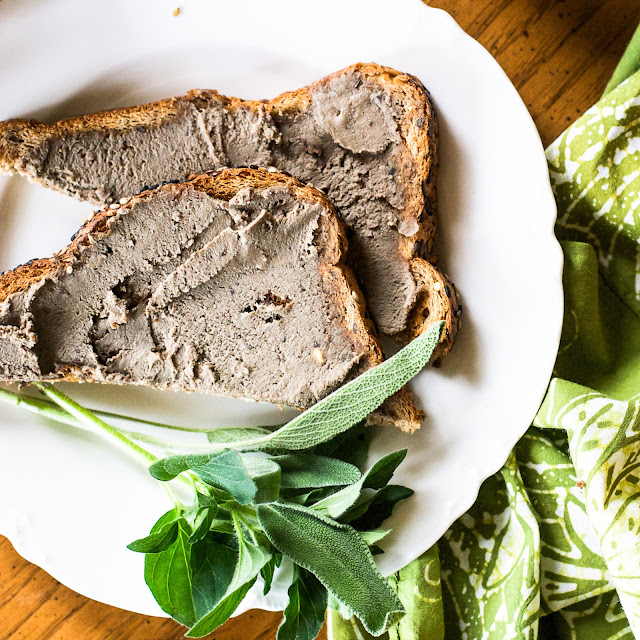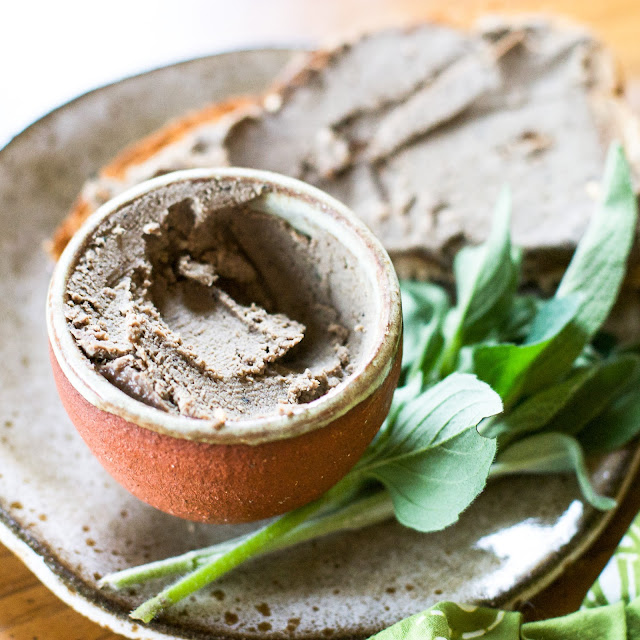Old World Lamb Liver Pâté

What a wonderful three-day weekend full of old friends, new
friends, and exciting memories!
The annual Ski to Sea celebration occurred this
weekend, changing Bellingham, the city of subdued excitement, to one bustling
and exciting community. Everyone is out to race as part of a 7-leg relay race
starting on top of Mt Baker and ending in Bellingham Bay. Days, weeks, and even
months of training are showcased and celebrated.
However, after a long day in the sun racing and cheering, I
am thankful for a peaceful and quiet rainy Memorial Day Monday. The perfect
time to clean the house, spruce up vases with beautiful fresh flowers, and get
bustling in the kitchen with jazz playing in the background…and perhaps an
afternoon nap might be in order. But first, since I have a little spare time on
my hands, and a super amazing food co-op find in my fridge (organic pasture-raised
lamb liver), I am going to make lamb liver pâté!

Now, for some of you, I know liver may not sound appealing since it is not commonly eaten in the American culture…..and it definitely has an acquired taste. However, in my family, since I am German, liver is a staple amongst many other organ meats. If you are new to liver, liver pâté is a good way to start, as it is seasoned well, and acts more like a spread or dip than like a cut of meat. I love to serve liver pâté as an appetizer with gluten-free crackers or sliced veggies like cucumbers. Or, simply spread it on toast or fresh crusty bread. Just use the liver pâté anyway you would use hummus.
Why liver??
Liver is simply amazing! Cultures have eaten
liver and other organ meats for centuries, regarding them as the best part of
the animal. And not surprisingly so! Since the liver plays multiple roles
within the body it requires many vitamins and minerals to complete it’s
functions. Therefore, the liver is a storage house of nutrition and
consequently it is known as nature’s natural multivitamin. For example, it is
extremely rich in B vitamins, biotin, choline, vitamin A, iron, copper, selenium,
and zinc. The amounts found in 3.5 oz of liver far outreach what you can find
in plant foods. Therefore, eating a little bit of liver as part of a whole foods
plant-based diet can be a very easy way to quickly increase the nutrient
density of your diet. Since liver is very high in vitamin A and cholesterol,
limiting it to small amounts a couple times a week is advised. And just as a
reminder, you must make sure to buy organic and pasture-raised liver to ensure
the highest quality.
I think everyone that enjoys liver
should eat liver occasionally. However, those that benefit most are those that
eat very little animal protein, those that have digestive issues of some sort
(IBD, IBS, SIBO, etc), high-intensity athletes, or women of child-bearing age. Often times these
populations either are not meeting their micronutrient needs through diet alone
or they have decreased micronutrient absorption. Therefore, because liver is so
rich in important vitamins and minerals it can be a wonderful restorative food
item to incorporate into your diet. Below you can see how liver stacks up to
other foods, including other animal protein (6).
APPLES (3.5oz)
|
CARROTS (3.5 oz)
|
RED MEAT (3.5 oz)
|
Lamb Liver (3.5 oz)
|
|
Calcium
|
3.0 mg
|
3.3 mg
|
11.0 mg
|
7.0 mg
|
Phosphorus
|
6.0 mg
|
31.0 mg
|
140.0 mg
|
360.0 mg
|
Magnesium
|
4.8 mg
|
6.2 mg
|
15.0 mg
|
19.0 mg
|
Potassium
|
139.0 mg
|
222.0 mg
|
370.0 mg
|
310.0 mg
|
Iron
|
.1 mg
|
.6 mg
|
3.3 mg
|
7.3 mg
|
Zinc
|
.05 mg
|
.3 mg
|
4.4 mg
|
4.6 mg
|
Selenium
|
0.0mcg
|
0.1mcg
|
21mcg
|
81mcg
|
Copper
|
.04 mg
|
.08 mg
|
.18 mg
|
7.0 mg
|
Vitamin A
|
None
|
None
|
40 IU
|
24,332 IU
|
Vitamin D
|
None
|
None
|
Trace
|
16 IU
|
Vitamin E
|
.37 mg
|
.11 mg
|
1.7 mg
|
.63 mg
|
Vitamin C
|
7.0 mg
|
6.0 mg
|
None
|
4.0 mg
|
Thiamin
|
.03 mg
|
.05 mg
|
.05 mg
|
.35 mg
|
Riboflavin
|
.02 mg
|
.05 mg
|
.20 mg
|
3.6 mg
|
Niacin
|
.10 mg
|
.60 mg
|
4.0 mg
|
16.0 mg
|
Pantothenic Acid
|
.11 mg
|
.19 mg
|
.42 mg
|
6.0 mg
|
Vitamin B6
|
.03 mg
|
.10 mg
|
.07 mg
|
.9 mg
|
Folic Acid
|
8.0 mcg
|
24.0 mcg
|
4.0 mcg
|
228.0 mcg
|
Biotin
|
None
|
.42 mcg
|
2.08 mcg
|
96.0 mcg
|
Choline
|
4mg
|
7mg
|
137mg
|
417mg
|
Vitamin B12
|
None
|
None
|
1.84 mcg
|
90 mcg
|
What are the health benefits of liver?
As you can see, liver stacks up pretty nicely, especially in
regards to B vitamins. B vitamins are very important for proper energy
production and metabolism, DNA synthesis, nervous system function, and the list
goes on (1-3). If your diet is low in B vitamins, more likely than not, you may
feel low energy and fatigue. Therefore, liver generally is a great addition to
support overall energy and well-being. Don't be surprised if you eat a little
liver pâté and get an energy boost after! Also, liver is a good source of zinc and selenium which are important co-factors in reducing oxidative stress in our bodies, and help support healthy immune and thyroid function (4-5).


So if you are feeling adventurous, or are already a liver connoisseur,
I recommend trying this delicious, super easy liver pâté. Seriously, make a
batch and freeze some for later. You
never know when you may crave some extra nutrition. Plus, it can even make a great
hostess gift if invited for dinner on the fly. Serve it with crackers, apples, olives, and some
aged hard cheeses and you got yourself a gourmet antipasti plate! If you want another recipe idea for liver check out this post!
Old World Lamb Liver Pâté
Makes about 2 ½ cups
INGREDIENTS
½ cup + 2 tablespoons organic grass-fed butter (I use
organic valley, green label)
2 cups diced yellow onion
2 cloves garlic, minced
1 tablespoon fresh sage, finely minced
1 tablespoon fresh oregano, finely minced
1 pound organic grass-fed lamb liver, diced or thinly sliced
2 tablespoons half and half
1 teaspoon Real sea salt
1 teaspoon fresh ground allspice (I use a clean coffee grinder to grind up allspice berries)
½ teaspoon ground pepper
INSTRUCTIONS
In a large skillet (not cast iron), heat the butter over
medium heat until melted. Reduce heat to medium low and add the yellow onion
and sauté 10 minutes. Then add the garlic and the freshly minced herbs. Sauté
another 10 minutes until the onions are caramelized.
Meanwhile cut away any membranes on the liver. Sometimes
this is already done depending what liver you buy, and if you can find it, it
will surely save you a bit of time! See this post for pictures if you still
need to cut away membranes.
When the onions are starting to caramelize reduce the heat
to low and with a slotted spoon transfer the onion mixture into a food
processor. Return the heat to medium and sauté the liver until no longer
bloody, but still slightly pink inside, just a couple minutes. Turn off the
heat and allow the lamb to cool a bit.
Meanwhile process the onion mixture until smooth. Then add
the liver, half and half, sea salt, allspice, and ground pepper. Process until
smooth.
Line a container with plastic wrap and pour the liver pâté into the container. Smooth with a spatula and cover. Refrigerate. Once cool and
hard you can turn the container over onto a plate and peel away the plastic
wrap, allowing you to slice the pâté OR just pour into a container from which
you can spoon the pâté out of.
Note: This recipe
makes a lot of pate. You can easily freeze the pâté and thaw for use later if
you need a quick and tasty appetizer or breakfast spread.
Reference:
1. Vitamin B6. http://lpi.oregonstate.edu/mic/vitamins/vitamin-B6.
Accessed March 27, 2015.
2. Folate. http://lpi.oregonstate.edu/mic/vitamins/folate.
Accessed March 27, 2015.
3. Vitamin B12. http://lpi.oregonstate.edu/mic/vitamins/vitamin-B12.
Accessed March 28, 2015.
4. Zinc. http://lpi.oregonstate.edu/mic/minerals/zinc.
Accessed March 27, 2015.
5. Selenium. http://lpi.oregonstate.edu/mic/minerals/selenium.
Accessed March 27, 2015.
6. SELF NutritionData. Lamb Liver. http://nutritiondata.self.com/facts/lamb-veal-and-game-products/4668/2.
Accessed March 27, 2015.




.jpg)